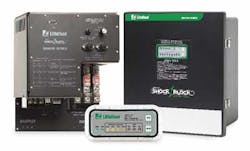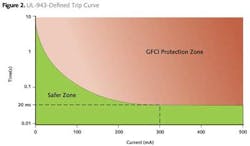By Nehad El-Sherif
How safe would you feel standing in water next to a high voltage pump? Unfortunately, that is the situation at a major water utility serving drinking water to 3 million residents. The utility has a water purification and pumping station with two tanks the size of Olympic swimming pools, but deeper, each containing a 7 to 10 horsepower submersible pump running on 600 VAC.
Once or twice a year, the tanks must be cleaned by hand, and workers enter them while water is still present and the pumps are running. Because water conducts electricity, the risk of electric shock increases where water comes in contact with electrical equipment and workers.
Each year, electricity kills hundreds of workers in the United States, and more than 66,000 workers were injured by it between 1992 and 2010. A strong current passing through the body can cause burns, but even a small current is dangerous if it passes across the heart (only 50 mA of current may cause ventricular fibrillation; see Fig 1). If the fibrillation continues for more than a few minutes without immediate medical intervention, then the worker will die.
Being proactive about safety, the supervisor at this municipal water facility wanted to protect the workers from electrical shock hazards and asked his electrical distributor for a solution. At first, the distributor suggested a ground fault relay but later learned of a new device for worker shock protection - an industrial ground fault circuit interrupter (GFCI).
How a GFCI Works
A single-phase GFCI compares current levels on outgoing and return conductors. Current that flows to ground (possibly through a worker's body) bypasses the return conductor, and its absence is measured. When the GFCI detects a dangerous level of ground fault current, it quickly interrupts the circuit.
The National Electrical Code® (NEC) requires the presence of GFCIs in residential buildings where water is present, such as bathrooms, laundry rooms and kitchens. For residential use, GFCIs trip at 6 mA, per the UL943 Class A standard. Unfortunately, these GFCIs cannot be used in industrial facilities, which have higher voltage, load current and leakage to ground. Even in industrial applications where the leakage to ground is less than 6 mA, there is a high probability that a Class A GFCI will nuisance trip.
GFCIs for Industrial and Municipal Water Suppliers
Advances in GFCI technology now make it possible to provide sensitive, low-level protection without nuisance tripping at higher voltages. Last year, UL approved the first GFCI for applications up to 600 V. UL 943C defines the characteristics expected of "special purpose" GFCIs operating up to 600 V. It sets the trip threshold at 20 mA - low enough to provide worker shock protection but high enough in most applications to avoid nuisance tripping.
UL 943 covers Class A (residential) GFCIs, while UL 943C separates industrial GFCIs into Classes C, D and E.
- Class A, under UL 943, is for residential application, with voltage of 120 or 240 volts single-phase installations, with a 6 mA trip level (too low for industrial use). Class A GFCIs are used in residential kitchens and bathrooms.
- Class C is for use in circuits with no conductor over 300 V to ground where reliable equipment grounding or double insulation is provided.
- Class D is for use in circuits with one or more conductors over 300 V to ground and with oversized grounding to prevent the voltage across the body during a fault from exceeding 150 volts.
- Class E covers equipment similar to Class D but with high-speed tripping required, not requiring the oversized ground of Class D.
UL wanted UL 943C to ensure a high level of safety. It required that the GFCI device monitor the ground wire for open connections, so that if the connection to ground is lost, the device will open the circuit. Ground wire monitoring ensures that voltage on the equipment chassis is not elevated relative to ground when an internal ground-fault occurs at the load. The device cannot be reset until the connection to ground is restored. This is an important safety feature often overlooked until it is too late.
The time it takes for a GFCI to trip depends on the level of ground fault current. All GFCIs follow a trip curve defined by UL 943 (see Fig. 2). This curve requires the GFCI to trip faster at higher current. At 20 mA, a GFCI must trip around one second. At 300 mA or higher, a GFCI must trip within 20 milliseconds. This is because the higher the current and the longer it continues, the greater the danger. The trip curve also helps minimize nuisance tripping by ignoring transient electrical events.
The supervisor of the water plant met with his distributor and received a demonstration of an industrial GFCI. He ordered two industrial GFCIs from Littelfuse. Normally these would be mounted in the motor control centers that supply power to each pump or ordered with their own enclosures and mounted like electrical panels.
In this case however, the supervisor is considering mounting the industrial GFCIs to wheeled carts in order to make them portable. The GFCI would connect to the power cable of a portable pump on one side and connect to a 600 V outlet with a power cable on the other side. The two portable GFCIs could be used for temporary dewatering applications at any facility in the utility's system.
Where to Apply Industrial GFCIs
Industrial GFCIs may be used anywhere, but they are particularly valuable in situations that combine electricity, people and the presence of water. This can include submersible pumps, aerators, mixers, and equipment subject to wash-down cleaning. Any damp or wet-work areas or locations where temporary loads are plugged into welding receptacles should be considered. Other candidate areas include dewatering pumps used for construction and maintenance activities. GFCIs are also valuable with high-voltage pumps used where there is frequent contact with operators or the public, such as in fountains, pools or water parks.
Although the first place to apply GFCI protection is in high-voltage equipment, such as a 480 or 600 V pump, the amount of ground fault current that can harm or kill someone is small. Therefore, an industrial GFCI is appropriate for lower voltage equipment if it is located in an area that sees frequent maintenance or frequent operator contact.
Alternatives to Industrial GFCIs
For higher leakage currents up to 50 mA, equipment ground fault protection devices (EGFPDs) can be used, although EGFPDs fall under a different UL standard and are intended for equipment and not personnel protection. In reality, EGFPDs also provide personnel protection where the industrial GFCIs cannot be used due to nuisance tripping.
Another device, the ground fault relay (GFR), or a ground fault monitor, could be confused with a GFCI but is quite different and used for alternative purposes.
A GFR does not open the circuit directly but triggers an upstream circuit breaker to open. While the GFR itself may react around a millisecond, the circuit breaker takes much longer to open - enough time for an electrical shock to stop someone's heart. In addition, the trip level of a GFR can be set anywhere up to 3 A (a fatal level of current), and its time delay can be set to as much as one second. Clearly GFRs are intended to protect equipment and not people.
In contrast, GFCIs are intended to protect personnel. A GFCI contains its own contactor to interrupt power much more quickly than a GFR, and its trip levels are set low enough to prevent ventricular fibrillation.
Summary
Water tanks can, over time, accumulate sediments that potentially impede water works operations and therefore need scheduled cleaning. Regular inspection and cleaning also helps prevent corrosion, extending the working life of a water storage reservoir.
The American Water Works Association (AWWA) recommends inspection of drinking water tanks at least every three years. In some states, public water suppliers are required to clean their tanks at least annually. To enable access, tanks are often temporarily removed from service and dewatered so workers are capable of entering them. Although utilities may contract this work, the utility or municipality is still responsible for providing a safe working environment for the contract workers. OSHA regulations state that every employer shall furnish a place of employment free from recognized hazards that are causing or likely to cause death or serious physical harm.
If a submersible pump is in the tank, the utility should consider installing an industrial GFCI that can protect workers from shock. The same is true of any high voltage equipment that comes into contact with water and requires frequent inspection or maintenance.
Presently, the National Electrical Code (NEC) does not require broad use of industrial GFCIs, but it does recommend their use for specific applications. Now that UL Listed industrial GFCIs are available, the adoption of such protection is expected to grow. Some experts feel it is only a matter of time before GFCIs are required by NEC and OSHA to protect workers in specific applications that involve water.
About the Author: Nehad El-Sherif, P.Eng. is the Technical Product Specialist for the protective relay products line for Littelfuse. El-Sharif has software and hardware design experience and has been involved in working on certification of various products with CSA and UL. He is a member of the CSA C22.2 No.144 standard committee, IEEE IAS and the IEEE Working Group on Industrial and Commercial Power Systems Communication Based Protection and SCADA. He can be reached by e-mail at [email protected], or by telephone at 1-306-657-1916.






